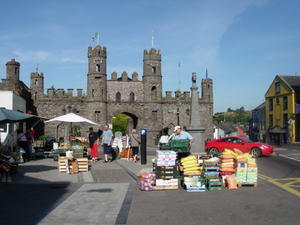Advertisement
Published: December 6th 2006

 Macroom Castle
Macroom Castle
James and Patrick stopped the bus in Macroom and gave us a half hour to explore. James told us that this castle was once owned by the father of William Penn who founded our home state of Pennsylvania. On the morning we arrived a little farmers' market was being set up.No need to describe the great breakfast. The rest of Irish/English food may not be all that exciting but they certainly give better breakfasts than the Italians and French.
James had us on the bus and out of the hotel parking lot before 9:00am. Once again it was a brilliant, sunny day. The temperatures were expected to rise as we went further inland.
We were headed to Blarney Castle on the old road through Macroom. Of course, this was probably the only road between the two towns but in any case, I learned after this trip that it was a very historic route. It was along this road that the IRA won their first major victory against the British forces at the Kilmichael Ambush in 1920. A week after "Sunday, Bloody Sunday" where the Brits pretty much kicked the butts of the fledgling IRA, the IRA staged a reprisal attack where they murdered 17 members of the Auxiliaries, a para-police force working for the British. The IRA stopped a couple of English trucks full of the Auxiliaries and shot them all without giving them a chance to surrender. Two guys escaped, one was shot in the head and permanently

 A pretty little place this Macroom is
A pretty little place this Macroom is
It might have been nice to spend more time here. Had I known about the whole IRA history of the area I would have bought a book in the nearby bookstore. As it was we didn't have much time to do anything here except take a couple photos.paralyzed while the other soldier that escaped was severely wounded. He headed to a nearby home seeking help only to find two IRA soldiers there. They killed him and dumped his body in the nearby bog. To their credit, most of the IRA troops involved in this brutal attack were so traumitized by it that they became physically sick and lost interest in the struggle. When the British headquarters learned of the attack they staged massive reprisals where farms and livestock were destroyed in revenge. The Kilmichael Ambush pretty much led to the escalation of hostilities with England and eventually became a landmark in the Irish history of independence.
A similar, less successful attack called the "Coolavokig Ambush" also took place in this area in 1921.
Of even greater significance was still another ambush on August 22, 1922 during the Irish Civil War. The Irish had won their independence but one faction approved the interim government that was set up while the rest of the IRA wanted to fight on. Soon it was Irish against Irish. One of the heroes of the War for Independence, Michael Collins, was the 32 year old leader of the group trying to

 The facade of Macroom Castle
The facade of Macroom Castle
I'm not sure what the deal was with this castle but just beyond this entrance gate there was absolutely nothing - just an alley and a bunch of buildings. Nothing that looked worth exploring. Perhaps the evil English destroyed everything that once sat inside the castle walls.lead a more peaceful break from the English. His pragmatic approach irritated the IRA types. While driving along the Macroom Road he was ambushed by the anti-Treaty forces and shot in the head. His youthful death did more to rally the people than the fight against the Brits.
I knew none of this as we drove. Once again this was not a super highway. We went through a number of little villages and past many many pastures full of many many sheep. Seeing the quaint town of Macroom was like arriving at an oasis in the desert of sameness.
Advertisement
Tot: 0.209s; Tpl: 0.013s; cc: 20; qc: 91; dbt: 0.124s; 1; m:domysql w:travelblog (10.17.0.13); sld: 1;
; mem: 1.3mb

 Macroom Castle
Macroom Castle
 A pretty little place this Macroom is
A pretty little place this Macroom is
 The facade of Macroom Castle
The facade of Macroom Castle

































Macroom Person
non-member comment
How dare you!
Listen you scumbag american how dare you comment on the IRA you know fuck all about what happend in irish history what gives you the right to talk down about the brave men and women who fought and gave there lives for irish freedom. God Bless The IRA